Analyzing Communication Objectives and Goals for Public Relations
VerifiedAdded on 2020/03/16
|8
|1683
|303
Report
AI Summary
This report examines the critical role of communication objectives and goals in public relations, emphasizing their importance in effective campaign planning. It defines goals as broad endpoints and objectives as measurable steps towards those goals, highlighting the use of the SMART acronym (Specific, Measurable, Actionable, Realistic, Time-based) for setting achievable targets. The report discusses the distinction between output and impact objectives, including behavioral, attitudinal, and informational impacts. It stresses the need for organizations to align communication strategies with their overall vision and goals, tailoring messages to specific audiences and measuring the outcomes of public relations initiatives. The report covers breaking down strategies into components, managing budgets, and creating public awareness to enhance an organization's value. It concludes by summarizing the importance of communication objectives and goals in providing specific reasons for communication within an organization, and how they reflect the campaign vision.
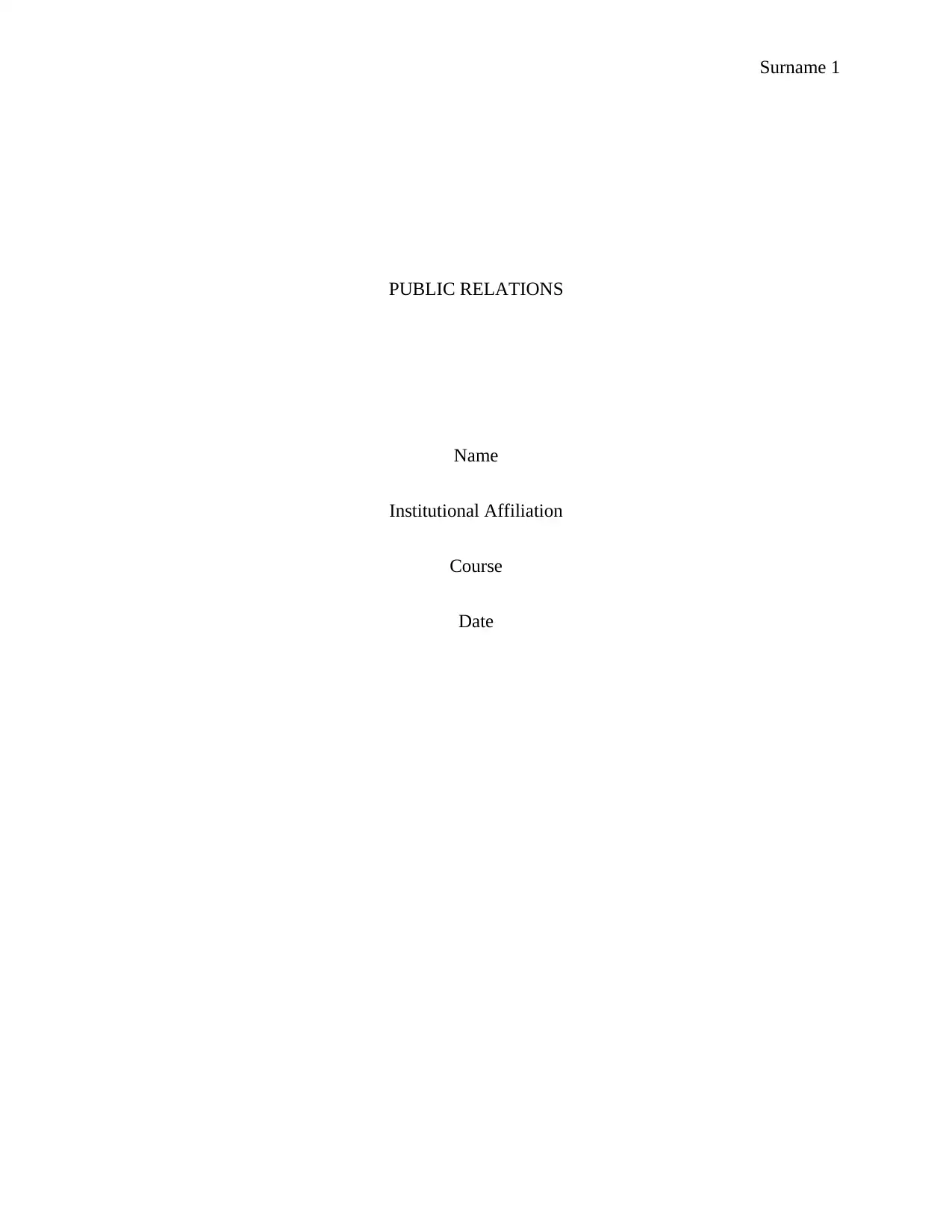
Surname 1
PUBLIC RELATIONS
Name
Institutional Affiliation
Course
Date
PUBLIC RELATIONS
Name
Institutional Affiliation
Course
Date
Paraphrase This Document
Need a fresh take? Get an instant paraphrase of this document with our AI Paraphraser
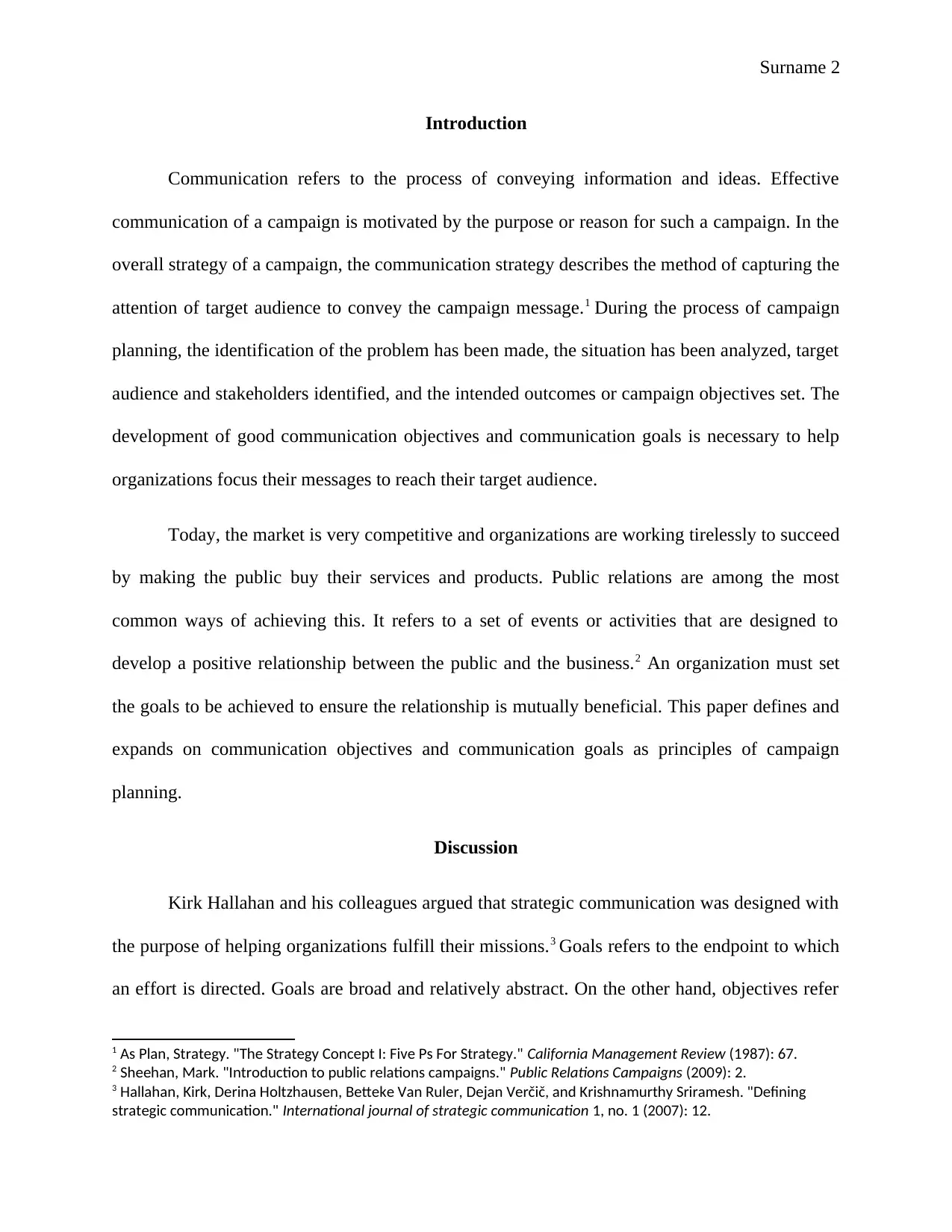
Surname 2
Introduction
Communication refers to the process of conveying information and ideas. Effective
communication of a campaign is motivated by the purpose or reason for such a campaign. In the
overall strategy of a campaign, the communication strategy describes the method of capturing the
attention of target audience to convey the campaign message.1 During the process of campaign
planning, the identification of the problem has been made, the situation has been analyzed, target
audience and stakeholders identified, and the intended outcomes or campaign objectives set. The
development of good communication objectives and communication goals is necessary to help
organizations focus their messages to reach their target audience.
Today, the market is very competitive and organizations are working tirelessly to succeed
by making the public buy their services and products. Public relations are among the most
common ways of achieving this. It refers to a set of events or activities that are designed to
develop a positive relationship between the public and the business.2 An organization must set
the goals to be achieved to ensure the relationship is mutually beneficial. This paper defines and
expands on communication objectives and communication goals as principles of campaign
planning.
Discussion
Kirk Hallahan and his colleagues argued that strategic communication was designed with
the purpose of helping organizations fulfill their missions.3 Goals refers to the endpoint to which
an effort is directed. Goals are broad and relatively abstract. On the other hand, objectives refer
1 As Plan, Strategy. "The Strategy Concept I: Five Ps For Strategy." California Management Review (1987): 67.
2 Sheehan, Mark. "Introduction to public relations campaigns." Public Relations Campaigns (2009): 2.
3 Hallahan, Kirk, Derina Holtzhausen, Betteke Van Ruler, Dejan Verčič, and Krishnamurthy Sriramesh. "Defining
strategic communication." International journal of strategic communication 1, no. 1 (2007): 12.
Introduction
Communication refers to the process of conveying information and ideas. Effective
communication of a campaign is motivated by the purpose or reason for such a campaign. In the
overall strategy of a campaign, the communication strategy describes the method of capturing the
attention of target audience to convey the campaign message.1 During the process of campaign
planning, the identification of the problem has been made, the situation has been analyzed, target
audience and stakeholders identified, and the intended outcomes or campaign objectives set. The
development of good communication objectives and communication goals is necessary to help
organizations focus their messages to reach their target audience.
Today, the market is very competitive and organizations are working tirelessly to succeed
by making the public buy their services and products. Public relations are among the most
common ways of achieving this. It refers to a set of events or activities that are designed to
develop a positive relationship between the public and the business.2 An organization must set
the goals to be achieved to ensure the relationship is mutually beneficial. This paper defines and
expands on communication objectives and communication goals as principles of campaign
planning.
Discussion
Kirk Hallahan and his colleagues argued that strategic communication was designed with
the purpose of helping organizations fulfill their missions.3 Goals refers to the endpoint to which
an effort is directed. Goals are broad and relatively abstract. On the other hand, objectives refer
1 As Plan, Strategy. "The Strategy Concept I: Five Ps For Strategy." California Management Review (1987): 67.
2 Sheehan, Mark. "Introduction to public relations campaigns." Public Relations Campaigns (2009): 2.
3 Hallahan, Kirk, Derina Holtzhausen, Betteke Van Ruler, Dejan Verčič, and Krishnamurthy Sriramesh. "Defining
strategic communication." International journal of strategic communication 1, no. 1 (2007): 12.
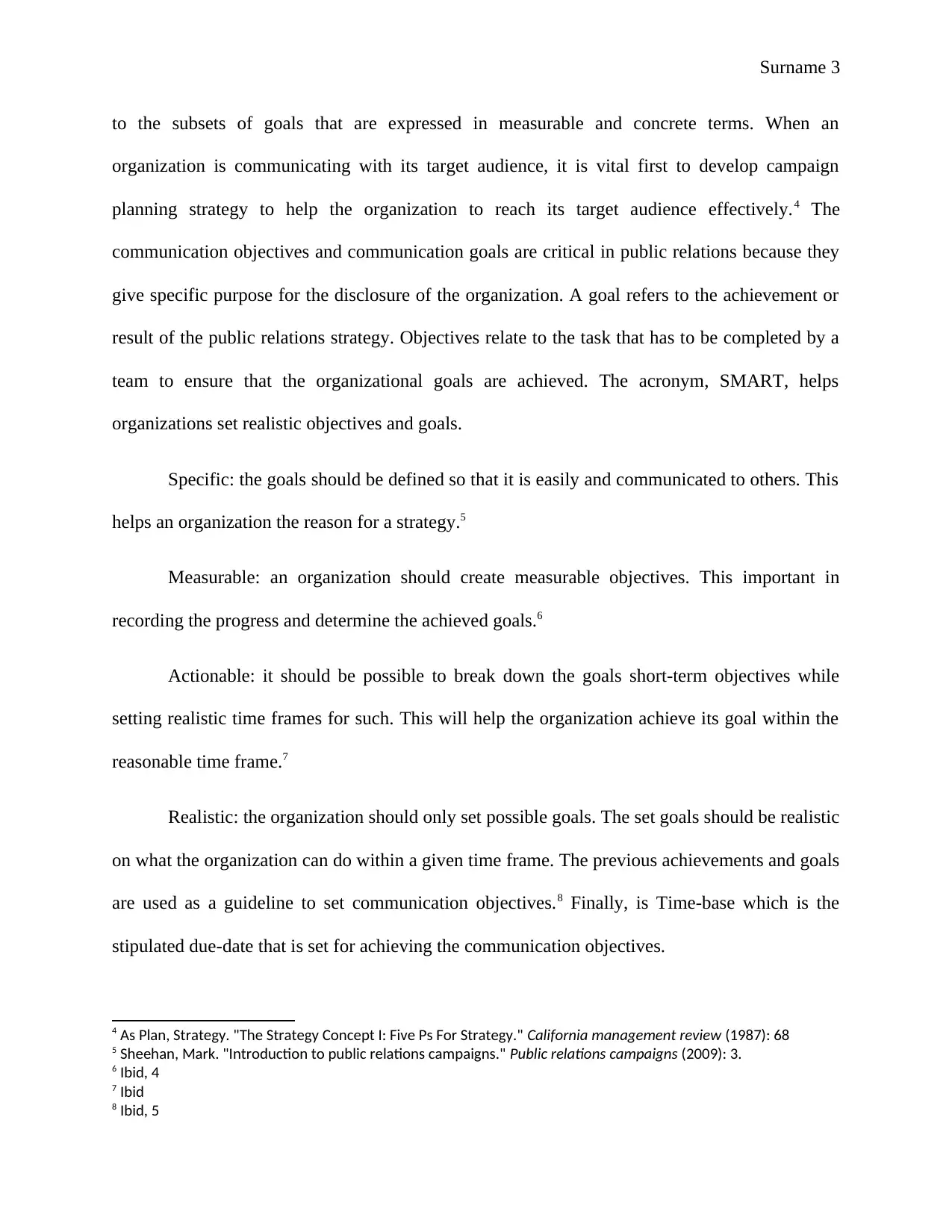
Surname 3
to the subsets of goals that are expressed in measurable and concrete terms. When an
organization is communicating with its target audience, it is vital first to develop campaign
planning strategy to help the organization to reach its target audience effectively.4 The
communication objectives and communication goals are critical in public relations because they
give specific purpose for the disclosure of the organization. A goal refers to the achievement or
result of the public relations strategy. Objectives relate to the task that has to be completed by a
team to ensure that the organizational goals are achieved. The acronym, SMART, helps
organizations set realistic objectives and goals.
Specific: the goals should be defined so that it is easily and communicated to others. This
helps an organization the reason for a strategy.5
Measurable: an organization should create measurable objectives. This important in
recording the progress and determine the achieved goals.6
Actionable: it should be possible to break down the goals short-term objectives while
setting realistic time frames for such. This will help the organization achieve its goal within the
reasonable time frame.7
Realistic: the organization should only set possible goals. The set goals should be realistic
on what the organization can do within a given time frame. The previous achievements and goals
are used as a guideline to set communication objectives.8 Finally, is Time-base which is the
stipulated due-date that is set for achieving the communication objectives.
4 As Plan, Strategy. "The Strategy Concept I: Five Ps For Strategy." California management review (1987): 68
5 Sheehan, Mark. "Introduction to public relations campaigns." Public relations campaigns (2009): 3.
6 Ibid, 4
7 Ibid
8 Ibid, 5
to the subsets of goals that are expressed in measurable and concrete terms. When an
organization is communicating with its target audience, it is vital first to develop campaign
planning strategy to help the organization to reach its target audience effectively.4 The
communication objectives and communication goals are critical in public relations because they
give specific purpose for the disclosure of the organization. A goal refers to the achievement or
result of the public relations strategy. Objectives relate to the task that has to be completed by a
team to ensure that the organizational goals are achieved. The acronym, SMART, helps
organizations set realistic objectives and goals.
Specific: the goals should be defined so that it is easily and communicated to others. This
helps an organization the reason for a strategy.5
Measurable: an organization should create measurable objectives. This important in
recording the progress and determine the achieved goals.6
Actionable: it should be possible to break down the goals short-term objectives while
setting realistic time frames for such. This will help the organization achieve its goal within the
reasonable time frame.7
Realistic: the organization should only set possible goals. The set goals should be realistic
on what the organization can do within a given time frame. The previous achievements and goals
are used as a guideline to set communication objectives.8 Finally, is Time-base which is the
stipulated due-date that is set for achieving the communication objectives.
4 As Plan, Strategy. "The Strategy Concept I: Five Ps For Strategy." California management review (1987): 68
5 Sheehan, Mark. "Introduction to public relations campaigns." Public relations campaigns (2009): 3.
6 Ibid, 4
7 Ibid
8 Ibid, 5
⊘ This is a preview!⊘
Do you want full access?
Subscribe today to unlock all pages.

Trusted by 1+ million students worldwide
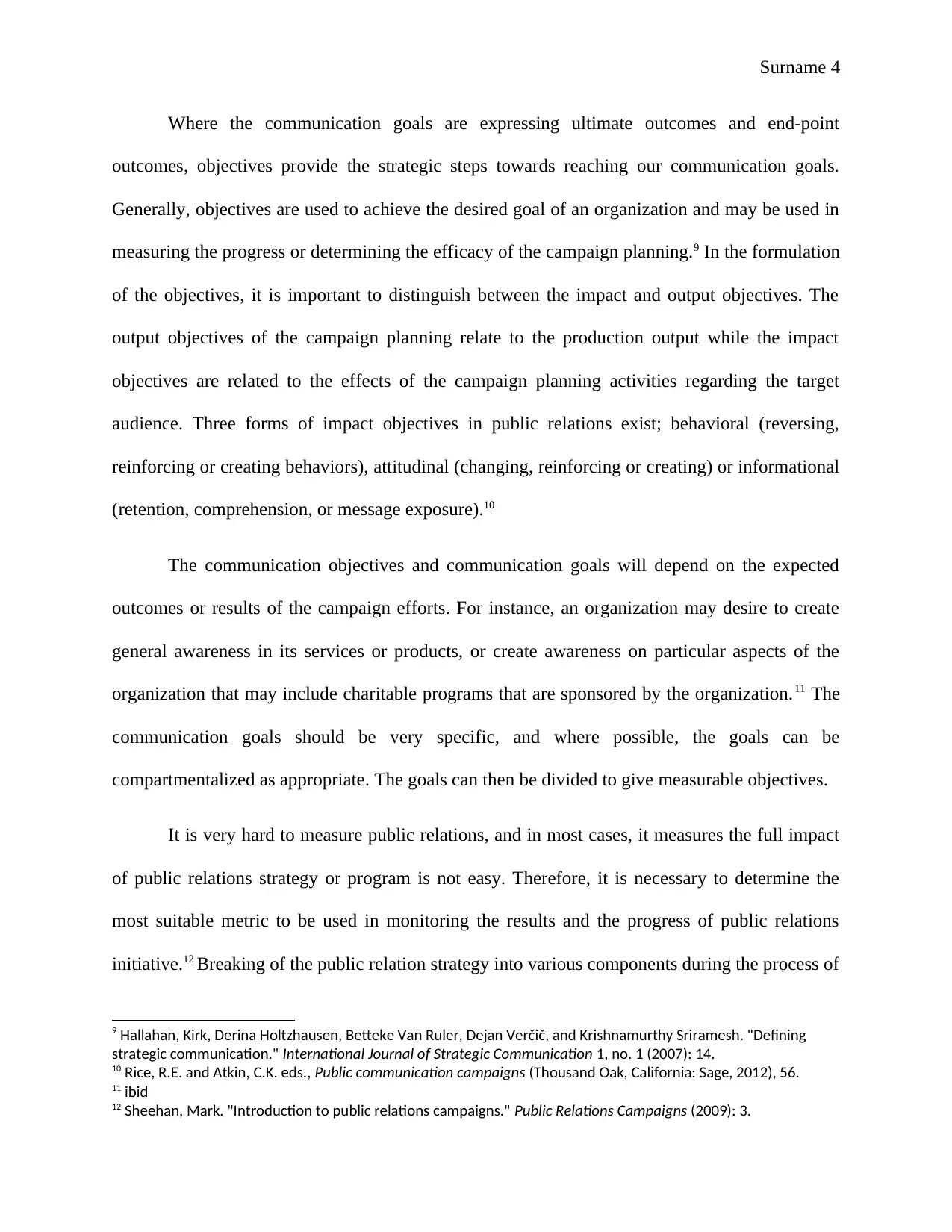
Surname 4
Where the communication goals are expressing ultimate outcomes and end-point
outcomes, objectives provide the strategic steps towards reaching our communication goals.
Generally, objectives are used to achieve the desired goal of an organization and may be used in
measuring the progress or determining the efficacy of the campaign planning.9 In the formulation
of the objectives, it is important to distinguish between the impact and output objectives. The
output objectives of the campaign planning relate to the production output while the impact
objectives are related to the effects of the campaign planning activities regarding the target
audience. Three forms of impact objectives in public relations exist; behavioral (reversing,
reinforcing or creating behaviors), attitudinal (changing, reinforcing or creating) or informational
(retention, comprehension, or message exposure).10
The communication objectives and communication goals will depend on the expected
outcomes or results of the campaign efforts. For instance, an organization may desire to create
general awareness in its services or products, or create awareness on particular aspects of the
organization that may include charitable programs that are sponsored by the organization.11 The
communication goals should be very specific, and where possible, the goals can be
compartmentalized as appropriate. The goals can then be divided to give measurable objectives.
It is very hard to measure public relations, and in most cases, it measures the full impact
of public relations strategy or program is not easy. Therefore, it is necessary to determine the
most suitable metric to be used in monitoring the results and the progress of public relations
initiative.12 Breaking of the public relation strategy into various components during the process of
9 Hallahan, Kirk, Derina Holtzhausen, Betteke Van Ruler, Dejan Verčič, and Krishnamurthy Sriramesh. "Defining
strategic communication." International Journal of Strategic Communication 1, no. 1 (2007): 14.
10 Rice, R.E. and Atkin, C.K. eds., Public communication campaigns (Thousand Oak, California: Sage, 2012), 56.
11 ibid
12 Sheehan, Mark. "Introduction to public relations campaigns." Public Relations Campaigns (2009): 3.
Where the communication goals are expressing ultimate outcomes and end-point
outcomes, objectives provide the strategic steps towards reaching our communication goals.
Generally, objectives are used to achieve the desired goal of an organization and may be used in
measuring the progress or determining the efficacy of the campaign planning.9 In the formulation
of the objectives, it is important to distinguish between the impact and output objectives. The
output objectives of the campaign planning relate to the production output while the impact
objectives are related to the effects of the campaign planning activities regarding the target
audience. Three forms of impact objectives in public relations exist; behavioral (reversing,
reinforcing or creating behaviors), attitudinal (changing, reinforcing or creating) or informational
(retention, comprehension, or message exposure).10
The communication objectives and communication goals will depend on the expected
outcomes or results of the campaign efforts. For instance, an organization may desire to create
general awareness in its services or products, or create awareness on particular aspects of the
organization that may include charitable programs that are sponsored by the organization.11 The
communication goals should be very specific, and where possible, the goals can be
compartmentalized as appropriate. The goals can then be divided to give measurable objectives.
It is very hard to measure public relations, and in most cases, it measures the full impact
of public relations strategy or program is not easy. Therefore, it is necessary to determine the
most suitable metric to be used in monitoring the results and the progress of public relations
initiative.12 Breaking of the public relation strategy into various components during the process of
9 Hallahan, Kirk, Derina Holtzhausen, Betteke Van Ruler, Dejan Verčič, and Krishnamurthy Sriramesh. "Defining
strategic communication." International Journal of Strategic Communication 1, no. 1 (2007): 14.
10 Rice, R.E. and Atkin, C.K. eds., Public communication campaigns (Thousand Oak, California: Sage, 2012), 56.
11 ibid
12 Sheehan, Mark. "Introduction to public relations campaigns." Public Relations Campaigns (2009): 3.
Paraphrase This Document
Need a fresh take? Get an instant paraphrase of this document with our AI Paraphraser
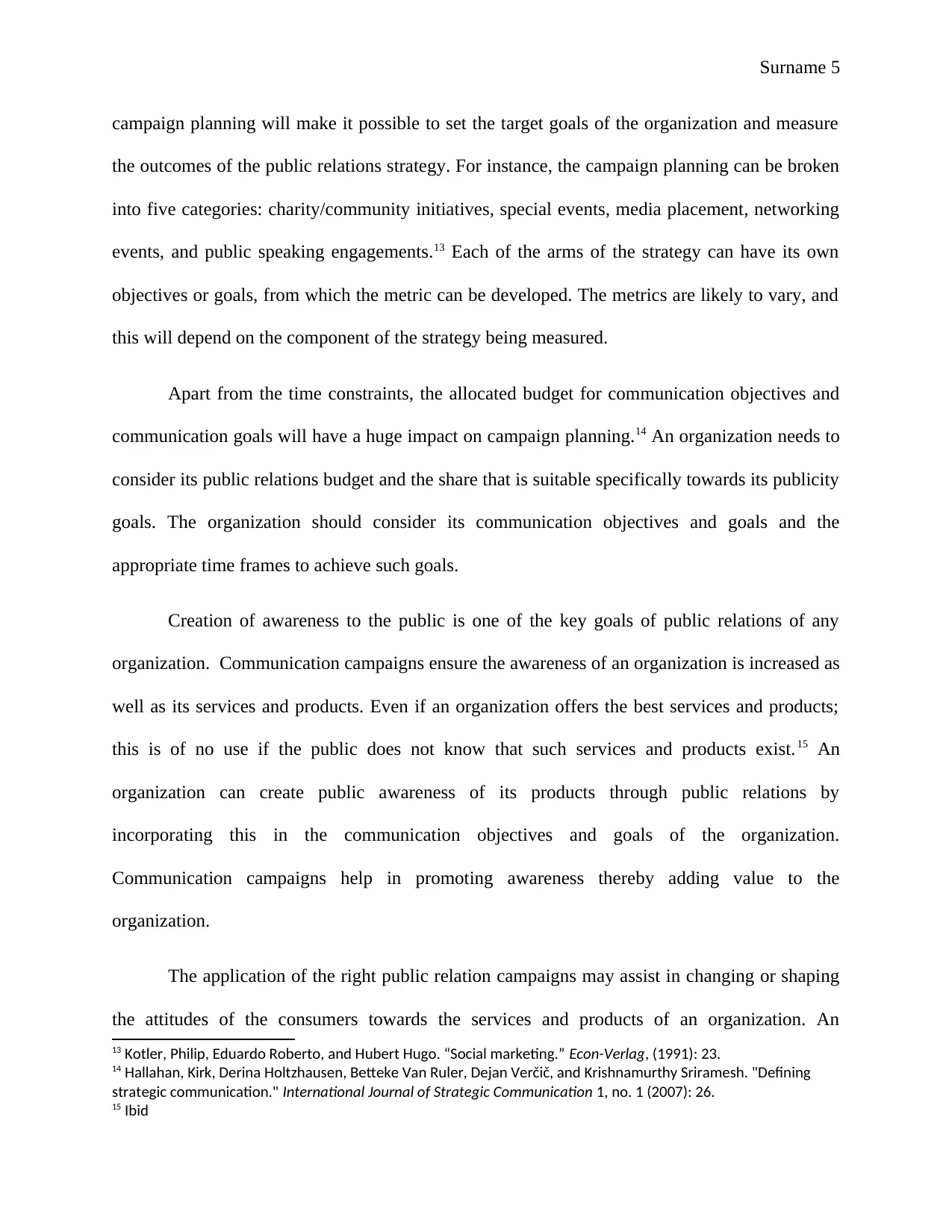
Surname 5
campaign planning will make it possible to set the target goals of the organization and measure
the outcomes of the public relations strategy. For instance, the campaign planning can be broken
into five categories: charity/community initiatives, special events, media placement, networking
events, and public speaking engagements.13 Each of the arms of the strategy can have its own
objectives or goals, from which the metric can be developed. The metrics are likely to vary, and
this will depend on the component of the strategy being measured.
Apart from the time constraints, the allocated budget for communication objectives and
communication goals will have a huge impact on campaign planning.14 An organization needs to
consider its public relations budget and the share that is suitable specifically towards its publicity
goals. The organization should consider its communication objectives and goals and the
appropriate time frames to achieve such goals.
Creation of awareness to the public is one of the key goals of public relations of any
organization. Communication campaigns ensure the awareness of an organization is increased as
well as its services and products. Even if an organization offers the best services and products;
this is of no use if the public does not know that such services and products exist.15 An
organization can create public awareness of its products through public relations by
incorporating this in the communication objectives and goals of the organization.
Communication campaigns help in promoting awareness thereby adding value to the
organization.
The application of the right public relation campaigns may assist in changing or shaping
the attitudes of the consumers towards the services and products of an organization. An
13 Kotler, Philip, Eduardo Roberto, and Hubert Hugo. “Social marketing.” Econ-Verlag, (1991): 23.
14 Hallahan, Kirk, Derina Holtzhausen, Betteke Van Ruler, Dejan Verčič, and Krishnamurthy Sriramesh. "Defining
strategic communication." International Journal of Strategic Communication 1, no. 1 (2007): 26.
15 Ibid
campaign planning will make it possible to set the target goals of the organization and measure
the outcomes of the public relations strategy. For instance, the campaign planning can be broken
into five categories: charity/community initiatives, special events, media placement, networking
events, and public speaking engagements.13 Each of the arms of the strategy can have its own
objectives or goals, from which the metric can be developed. The metrics are likely to vary, and
this will depend on the component of the strategy being measured.
Apart from the time constraints, the allocated budget for communication objectives and
communication goals will have a huge impact on campaign planning.14 An organization needs to
consider its public relations budget and the share that is suitable specifically towards its publicity
goals. The organization should consider its communication objectives and goals and the
appropriate time frames to achieve such goals.
Creation of awareness to the public is one of the key goals of public relations of any
organization. Communication campaigns ensure the awareness of an organization is increased as
well as its services and products. Even if an organization offers the best services and products;
this is of no use if the public does not know that such services and products exist.15 An
organization can create public awareness of its products through public relations by
incorporating this in the communication objectives and goals of the organization.
Communication campaigns help in promoting awareness thereby adding value to the
organization.
The application of the right public relation campaigns may assist in changing or shaping
the attitudes of the consumers towards the services and products of an organization. An
13 Kotler, Philip, Eduardo Roberto, and Hubert Hugo. “Social marketing.” Econ-Verlag, (1991): 23.
14 Hallahan, Kirk, Derina Holtzhausen, Betteke Van Ruler, Dejan Verčič, and Krishnamurthy Sriramesh. "Defining
strategic communication." International Journal of Strategic Communication 1, no. 1 (2007): 26.
15 Ibid
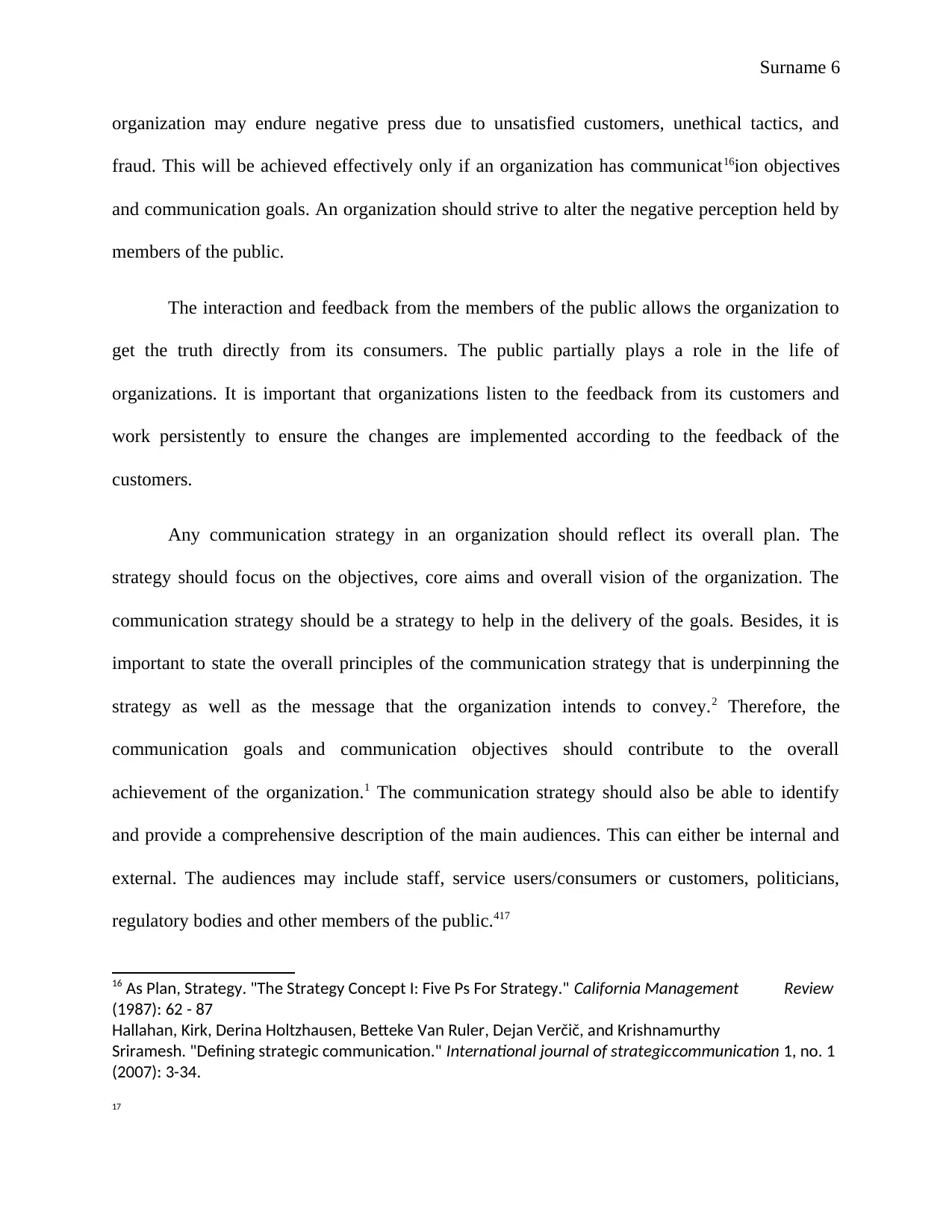
Surname 6
organization may endure negative press due to unsatisfied customers, unethical tactics, and
fraud. This will be achieved effectively only if an organization has communicat16ion objectives
and communication goals. An organization should strive to alter the negative perception held by
members of the public.
The interaction and feedback from the members of the public allows the organization to
get the truth directly from its consumers. The public partially plays a role in the life of
organizations. It is important that organizations listen to the feedback from its customers and
work persistently to ensure the changes are implemented according to the feedback of the
customers.
Any communication strategy in an organization should reflect its overall plan. The
strategy should focus on the objectives, core aims and overall vision of the organization. The
communication strategy should be a strategy to help in the delivery of the goals. Besides, it is
important to state the overall principles of the communication strategy that is underpinning the
strategy as well as the message that the organization intends to convey.2 Therefore, the
communication goals and communication objectives should contribute to the overall
achievement of the organization.1 The communication strategy should also be able to identify
and provide a comprehensive description of the main audiences. This can either be internal and
external. The audiences may include staff, service users/consumers or customers, politicians,
regulatory bodies and other members of the public.417
16 As Plan, Strategy. "The Strategy Concept I: Five Ps For Strategy." California Management Review
(1987): 62 - 87
Hallahan, Kirk, Derina Holtzhausen, Betteke Van Ruler, Dejan Verčič, and Krishnamurthy
Sriramesh. "Defining strategic communication." International journal of strategiccommunication 1, no. 1
(2007): 3-34.
17
organization may endure negative press due to unsatisfied customers, unethical tactics, and
fraud. This will be achieved effectively only if an organization has communicat16ion objectives
and communication goals. An organization should strive to alter the negative perception held by
members of the public.
The interaction and feedback from the members of the public allows the organization to
get the truth directly from its consumers. The public partially plays a role in the life of
organizations. It is important that organizations listen to the feedback from its customers and
work persistently to ensure the changes are implemented according to the feedback of the
customers.
Any communication strategy in an organization should reflect its overall plan. The
strategy should focus on the objectives, core aims and overall vision of the organization. The
communication strategy should be a strategy to help in the delivery of the goals. Besides, it is
important to state the overall principles of the communication strategy that is underpinning the
strategy as well as the message that the organization intends to convey.2 Therefore, the
communication goals and communication objectives should contribute to the overall
achievement of the organization.1 The communication strategy should also be able to identify
and provide a comprehensive description of the main audiences. This can either be internal and
external. The audiences may include staff, service users/consumers or customers, politicians,
regulatory bodies and other members of the public.417
16 As Plan, Strategy. "The Strategy Concept I: Five Ps For Strategy." California Management Review
(1987): 62 - 87
Hallahan, Kirk, Derina Holtzhausen, Betteke Van Ruler, Dejan Verčič, and Krishnamurthy
Sriramesh. "Defining strategic communication." International journal of strategiccommunication 1, no. 1
(2007): 3-34.
17
⊘ This is a preview!⊘
Do you want full access?
Subscribe today to unlock all pages.

Trusted by 1+ million students worldwide
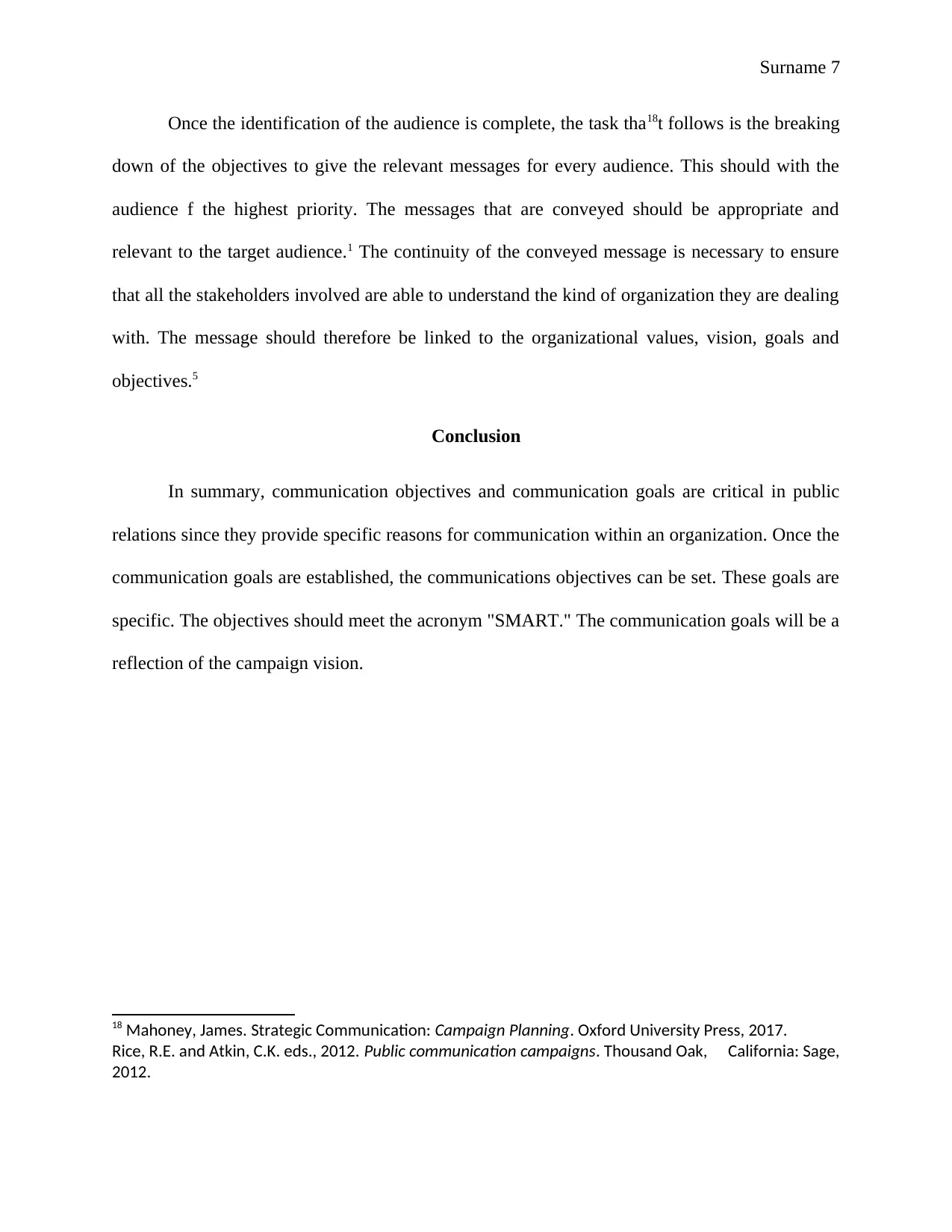
Surname 7
Once the identification of the audience is complete, the task tha18t follows is the breaking
down of the objectives to give the relevant messages for every audience. This should with the
audience f the highest priority. The messages that are conveyed should be appropriate and
relevant to the target audience.1 The continuity of the conveyed message is necessary to ensure
that all the stakeholders involved are able to understand the kind of organization they are dealing
with. The message should therefore be linked to the organizational values, vision, goals and
objectives.5
Conclusion
In summary, communication objectives and communication goals are critical in public
relations since they provide specific reasons for communication within an organization. Once the
communication goals are established, the communications objectives can be set. These goals are
specific. The objectives should meet the acronym "SMART." The communication goals will be a
reflection of the campaign vision.
18 Mahoney, James. Strategic Communication: Campaign Planning. Oxford University Press, 2017.
Rice, R.E. and Atkin, C.K. eds., 2012. Public communication campaigns. Thousand Oak, California: Sage,
2012.
Once the identification of the audience is complete, the task tha18t follows is the breaking
down of the objectives to give the relevant messages for every audience. This should with the
audience f the highest priority. The messages that are conveyed should be appropriate and
relevant to the target audience.1 The continuity of the conveyed message is necessary to ensure
that all the stakeholders involved are able to understand the kind of organization they are dealing
with. The message should therefore be linked to the organizational values, vision, goals and
objectives.5
Conclusion
In summary, communication objectives and communication goals are critical in public
relations since they provide specific reasons for communication within an organization. Once the
communication goals are established, the communications objectives can be set. These goals are
specific. The objectives should meet the acronym "SMART." The communication goals will be a
reflection of the campaign vision.
18 Mahoney, James. Strategic Communication: Campaign Planning. Oxford University Press, 2017.
Rice, R.E. and Atkin, C.K. eds., 2012. Public communication campaigns. Thousand Oak, California: Sage,
2012.
Paraphrase This Document
Need a fresh take? Get an instant paraphrase of this document with our AI Paraphraser
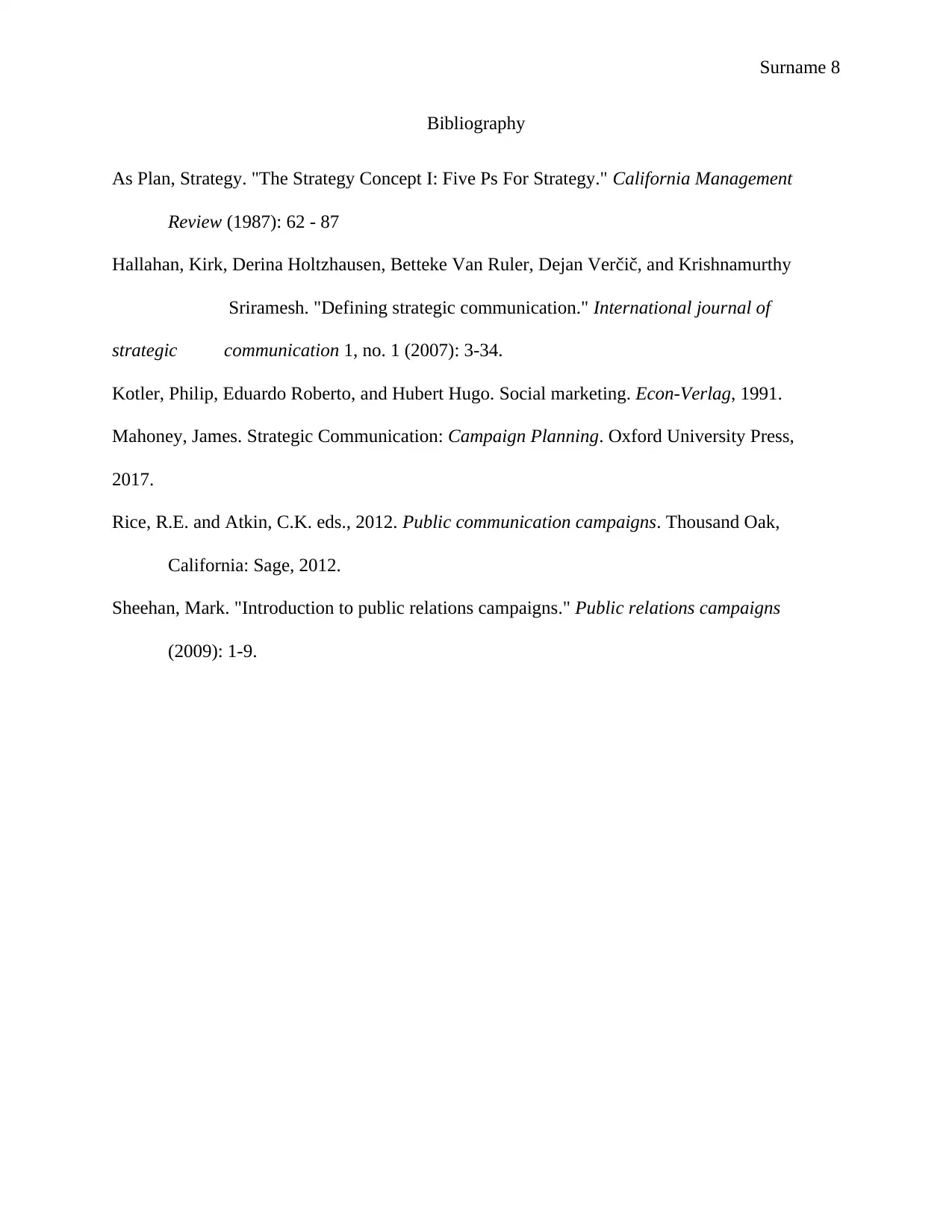
Surname 8
Bibliography
As Plan, Strategy. "The Strategy Concept I: Five Ps For Strategy." California Management
Review (1987): 62 - 87
Hallahan, Kirk, Derina Holtzhausen, Betteke Van Ruler, Dejan Verčič, and Krishnamurthy
Sriramesh. "Defining strategic communication." International journal of
strategic communication 1, no. 1 (2007): 3-34.
Kotler, Philip, Eduardo Roberto, and Hubert Hugo. Social marketing. Econ-Verlag, 1991.
Mahoney, James. Strategic Communication: Campaign Planning. Oxford University Press,
2017.
Rice, R.E. and Atkin, C.K. eds., 2012. Public communication campaigns. Thousand Oak,
California: Sage, 2012.
Sheehan, Mark. "Introduction to public relations campaigns." Public relations campaigns
(2009): 1-9.
Bibliography
As Plan, Strategy. "The Strategy Concept I: Five Ps For Strategy." California Management
Review (1987): 62 - 87
Hallahan, Kirk, Derina Holtzhausen, Betteke Van Ruler, Dejan Verčič, and Krishnamurthy
Sriramesh. "Defining strategic communication." International journal of
strategic communication 1, no. 1 (2007): 3-34.
Kotler, Philip, Eduardo Roberto, and Hubert Hugo. Social marketing. Econ-Verlag, 1991.
Mahoney, James. Strategic Communication: Campaign Planning. Oxford University Press,
2017.
Rice, R.E. and Atkin, C.K. eds., 2012. Public communication campaigns. Thousand Oak,
California: Sage, 2012.
Sheehan, Mark. "Introduction to public relations campaigns." Public relations campaigns
(2009): 1-9.
1 out of 8
Related Documents
Your All-in-One AI-Powered Toolkit for Academic Success.
+13062052269
info@desklib.com
Available 24*7 on WhatsApp / Email
![[object Object]](/_next/static/media/star-bottom.7253800d.svg)
Unlock your academic potential
Copyright © 2020–2025 A2Z Services. All Rights Reserved. Developed and managed by ZUCOL.





